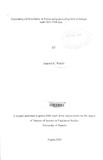| dc.description.abstract | Due to non-functioning and incomplete vital registration systems in many developing
countries, estimates of mortality is by indirect methods which derive data from
retrospective information obtained at the time of national censuses or from specialized
demographic sample surveys. Most of these methods suffer from various weaknesses
varying from low quality of original data, large volume of data requirement, historical data
i.e not up-to-date and hence likely to suffer recall errors, high costs of data collection, and
are very complicated and difficult to use especially in the field. Preceding Birth Technique
is an indirect method providing early childhood mortality estimates derived from minimal
data about preceding births and their survival status. It is simple, easy to administer even in
the field and gives almost up-to-date estimates. The proportion dead among the preceding
births, IT, has been found to estimate child mortality by age two years. This study seeks to
estimate early child mortality in Kenya and to establish reliability of the technique in
producing differential effects from mothers' socio-economic characteristics. The findings
are inconclusive using medical data. While results derived from survival data on all
preceding births reported in the survey indicate that the technique is suitable in the
, ,
moderate to high mortality zones, though 'if consistently underestimate mortality.
Comparing medical assisted proportion dead, ITm, to all preceding births, ITa, derived from
• data based on two years reporting period gave statistically significant differences while data
based on five years reporting period improved the results. The significant difference is
therefore attributed to selection bias and small sample sizes, which could not give
meaningful results. Comparing IT to life table proportion, q(2) provided plausible results in
overall for all preceding births reported in the survey and in particular in the moderate to
high early child mortality zones in Kenya. | en |

